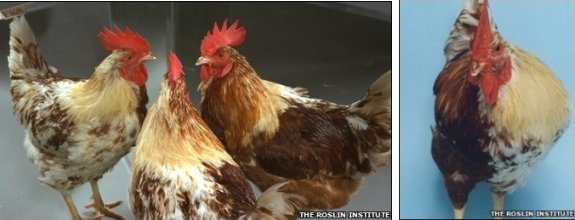
Gynandromorphous research results

I recently discovered that 1
in every 10,000 chickens turns out to be gynandromorphous, half hen,
half rooster, thanks to a recent
BBC article.
Dr Michael Clinton of the
Roslin Institute has just published some of the latest research on the
subject in the scientific journal Nature.
They came up with a
surprising conclusion. The system is different from mammals in that
there is no mutation and the birds are full male on one side and full
female on the other.
Of course the hope is to find
a way to increase production in the poultry business by making female
birds with the same growth characteristics as the male to "increase
productivity and food security".
Want more in-depth information? Browse through our books.
Or explore more posts by date or by subject.
About us: Anna Hess and Mark Hamilton spent over a decade living self-sufficiently in the mountains of Virginia before moving north to start over from scratch in the foothills of Ohio. They've experimented with permaculture, no-till gardening, trailersteading, home-based microbusinesses and much more, writing about their adventures in both blogs and books.
Want to be notified when new comments are posted on this page? Click on the RSS button after you add a comment to subscribe to the comment feed, or simply check the box beside "email replies to me" while writing your comment.

Personally, I think that intensive chicken farming is cruel and unsanitary. The fact that chickens on these farms are de-beaked lest they peck each other to death speaks volumes in that regard. Store-bought chicken is very often infested with E coli (between 40% and 99%, depending on the study) and samonella (up to 25%). Free range chickens have a much better life, provided you don't keep thousands. It seems that any large scale chicken farming can have disease and cannibalism problems.
Also, the feed conversion ratio of breeding chickens, while not as bad as cattle is still in the order of 2-4, which isn't very efficient. The ratio of edible proteins to feed proteins is about 1:3, also not very favorable.
I think pigs are supposed to have the best feed conversion ratio.
I wouldn't be so sure that free range chickens were much better off --- although maybe the rules are different in Europe. Over here, "free range" could just mean that rather than being each in their little cage, the same number of birds are stuffed into a warehouse. Large scale meat operations are just inherently cruel and environmentally unfriendly.
The Wikipedia article on free range lists the EU regulations, which are quite good, I think.
AFAICT, the best food conversion ratio is found in fish (salmon/trout) close to 1. Pigs seems to be in the same range as chickens.
I've been wondering how efficiently we humans can metabolize vegetable proteins as opposed to animal proteins. Skipping a link of the chain and eating vegetable protein directly sounds more efficient to me. But that's the engineer in me talking. I haven't found any hard evidence yet.
I thought I'd read good things about the EU's version of "free range." As usual, you've got us beat by a mile!
Most environmental writers will tell you that eating vegetable protein is much more land efficient than eating meat. On the other hand, I'm a big proponent of permaculture, which puts animals back into the ecosystem but at a more environmentally friendly level. Animals make sense on small, diversified farms since they add fertility to the soil. The trick is not to go overboard and eat meat twice a day, thus requiring CAFOs.